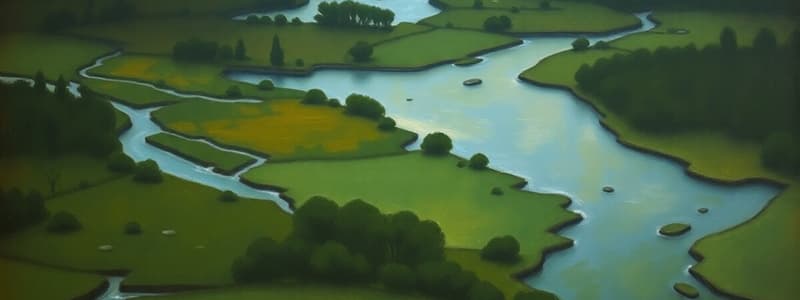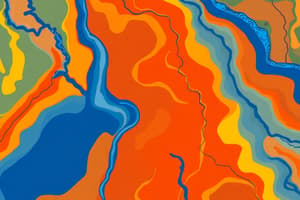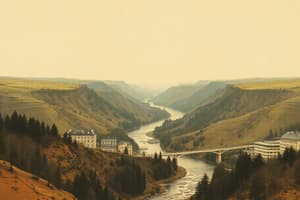Podcast
Questions and Answers
What is the primary function of a drainage basin?
What is the primary function of a drainage basin?
- To store large quantities of groundwater
- To maintain the water table levels
- To collect and direct water into a common outlet (correct)
- To prevent soil erosion in a specific area
What term is used interchangeably with drainage basin?
What term is used interchangeably with drainage basin?
- Floodplain
- Groundwater table
- Water catchment (correct)
- Erosion zone
What is a drainage divide?
What is a drainage divide?
- An area where water stagnates
- The boundary between two drainage basins (correct)
- A flat area of land with no slope
- A body of water in a basin
Which of the following best describes a basin in geography?
Which of the following best describes a basin in geography?
What is the relationship between small water basins and a drainage basin system?
What is the relationship between small water basins and a drainage basin system?
In the context of drainage basin systems, what is a tributary?
In the context of drainage basin systems, what is a tributary?
How are the watersheds within a drainage basin related?
How are the watersheds within a drainage basin related?
Which of the following is a correct example of a drainage basin?
Which of the following is a correct example of a drainage basin?
What defines a watershed?
What defines a watershed?
Which statement is true about first-order streams?
Which statement is true about first-order streams?
What is the role of gravity in the formation of drainage basins?
What is the role of gravity in the formation of drainage basins?
How do tributaries affect the size of river systems?
How do tributaries affect the size of river systems?
What is the common outlet for the Mississippi River drainage basin?
What is the common outlet for the Mississippi River drainage basin?
Which mountain range forms a boundary for the western drainage divide of the Mississippi River?
Which mountain range forms a boundary for the western drainage divide of the Mississippi River?
How many orders of waterways have scientists identified?
How many orders of waterways have scientists identified?
Flashcards
Drainage Basin
Drainage Basin
An area of land where precipitation and water flow into a common waterway or body of water.
Watershed
Watershed
Another name for a drainage basin.
Drainage Basin System
Drainage Basin System
A group of smaller drainage basins that flow into a larger river or body of water.
Water Basin
Water Basin
Signup and view all the flashcards
Drainage Divide
Drainage Divide
Signup and view all the flashcards
Tributary
Tributary
Signup and view all the flashcards
Basin (landform)
Basin (landform)
Signup and view all the flashcards
Catchment
Catchment
Signup and view all the flashcards
First-order stream
First-order stream
Signup and view all the flashcards
Divide
Divide
Signup and view all the flashcards
Drainage basin example (Mississippi River)
Drainage basin example (Mississippi River)
Signup and view all the flashcards
River system
River system
Signup and view all the flashcards
Study Notes
Drainage Basins
- A drainage basin is an area of land where precipitation, springs, or flow collects and drains into a common body of water (e.g., river, lake, ocean). Also called watersheds or catchments.
- Drainage basins vary in size, from small areas collecting rainwater to large areas with many rivers.
- Higher land surrounding a basin directs water downhill into the waterway.
- The ultimate outlet can be a river, lake, wetland, bay, or ocean.
Drainage Basin Systems
- A drainage basin system is composed of smaller water basins.
- Small areas drain water into a common body of water with a common outlet, forming small water basins.
- Tributaries feed into larger rivers, and smaller watersheds are part of larger systems.
- For example, the Republican River basin collects water from the midwestern plains, and is part of the larger Missouri River and Mississippi River basins.
Basin in Geography
- A basin is a circular or oval-shaped depression in the Earth's surface.
- Basins can be formed by erosion or other forces and can be dry or contain water.
- The sides of a basin are higher than the bottom.
- Examples of basins include the Republican River basin.
Drainage Divides
- Drainage divides are high ground areas that separate drainage basin systems.
- Divides can be mountain ranges or ridges.
- Precipitation on a divide flows into only one basin.
Watershed Characteristics
- Watersheds are drainage basins (land surrounded by higher land ridges) through which both surface and groundwater flows.
- Watershed characteristics can vary greatly.
- May have steep or gentle slopes.
- Drainage areas can be large and flat, or narrow and steep.
- Human activity affects and is affected by watershed characteristics.
Formation of Drainage Basins and River Systems
- Drainage basins and river systems form due to gravity-induced water flow (precipitation, springs).
- River systems start with runoff (water flowing across the land).
- Small watersheds (from a rill) become part of larger drainage basins.
- A first-order stream forms when runoff and springs combine and flow at least 90% of the time.
- First-order streams are small, fast-moving, and have no tributaries.
- When first-order streams merge, they form higher-order streams (second-order, etc.).
- River systems and their drainage areas grow with the merging of smaller ones into larger ones.
- Scientists use a 12-order stream classification system. (Mississippi 10-11th order, Amazon 12th order).
Drainage Basin Examples
- All rivers originate from a watershed or drainage basin.
- Large basins are made up of numerous smaller basins.
- Examples include the Mississippi River basin (one of the largest globally).
- The Mississippi River basin drains 1.2 million square miles in the central United States.
- The basin includes many tributaries – Missouri, Ohio, Arkansas.
- These tributaries have their own watersheds.
- The Mississippi River's common outlet is the Gulf of Mexico.
- Rocky Mountains and Appalachian Mountains form western and eastern drainage divide boundaries, respectively.
Studying That Suits You
Use AI to generate personalized quizzes and flashcards to suit your learning preferences.




